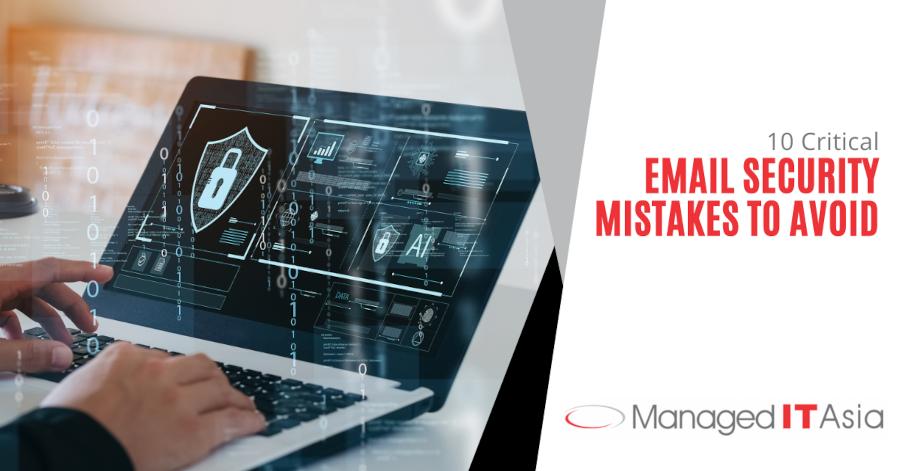In today’s digital landscape, email remains a primary communication tool for businesses and individuals alike. However, it’s also a prime target for cybercriminals seeking to exploit vulnerabilities and gain unauthorized access to sensitive information. To protect yourself and your organization from potential threats, it’s crucial to be aware of common email security mistakes and take proactive measures to avoid them.
Understanding the Importance of Email Security
Email security is not just about protecting your inbox; it’s about safeguarding your entire digital identity and the sensitive information you exchange. With the increasing sophistication of cyber attacks, even a single oversight can lead to devastating consequences, including data breaches, financial losses, and reputational damage.
Common Email Security Mistakes
1. Weak Password Practices
One of the most fundamental yet often overlooked aspects of email security is password strength. Using easily guessable passwords or reusing the same password across multiple accounts significantly increases your vulnerability to attacks. Implement strong, unique passwords for each account and consider using a password manager to keep track of them securely.
2. Neglecting Two-Factor Authentication
Two-factor authentication (2FA) adds an extra layer of security by requiring a second form of verification beyond just a password. Failing to enable 2FA on your email accounts leaves them more susceptible to unauthorized access, even if your password is compromised.
3. Falling for Phishing Scams
Phishing attacks remain one of the most prevalent email security threats. These deceptive emails often appear to be from legitimate sources, tricking recipients into revealing sensitive information or clicking on malicious links. Always verify the sender’s identity and be cautious of unexpected requests for personal information or urgent actions.
4. Ignoring Software Updates
Outdated email clients and operating systems often contain known vulnerabilities that cybercriminals can exploit. Regularly updating your software and applications ensures you have the latest security patches and protections against emerging threats.
Advanced Email Security Considerations
5. Lack of Email Encryption
Sending sensitive information through unencrypted emails is akin to sending a postcard through the mail – anyone along the way can potentially read its contents. Implement end-to-end encryption for confidential communications to ensure that only the intended recipient can access the message.
6. Overlooking Mobile Device Security
With the increasing use of smartphones and tablets for email access, mobile device security is crucial. Failing to secure these devices with passcodes, biometric authentication, and remote wipe capabilities can leave your email vulnerable if the device is lost or stolen.
7. Insufficient Email Filtering
Relying solely on basic spam filters leaves your inbox exposed to sophisticated threats. Implement advanced email filtering solutions that can detect and quarantine suspicious emails, including those with potential malware attachments or phishing attempts.
Organizational Email Security Mistakes
8. Lack of Employee Training
Even the most robust technical security measures can be undermined by human error. Failing to provide comprehensive and ongoing email security training to employees leaves organizations vulnerable to social engineering attacks and inadvertent security breaches.
9. Inadequate Backup and Recovery Procedures
In the event of a successful email-based attack, such as ransomware, having reliable backup and recovery procedures is crucial. Neglecting to regularly backup email data and test restoration processes can lead to permanent data loss and extended downtime.
10. Ignoring Insider Threats
While external threats often dominate the conversation around email security, insider threats pose a significant risk as well. Failing to implement proper access controls, monitor user activity, and enforce the principle of least privilege can leave organizations vulnerable to internal security breaches.
Best Practices for Enhanced Email Security
To mitigate these risks and strengthen your email security posture, consider implementing the following best practices:
- Regularly update and patch all email-related software and systems
- Implement and enforce strong password policies
- Enable two-factor authentication across all accounts
- Provide ongoing security awareness training to all users
- Use email encryption for sensitive communications
- Implement advanced email filtering and threat detection solutions
- Regularly back up email data and test recovery procedures
- Conduct periodic security audits and assessments
By addressing these common email security mistakes and implementing robust security measures, you can significantly reduce the risk of email-based attacks and protect your valuable digital assets.
Increase Your Email Security Today
Email security is an ongoing process that requires vigilance, education, and the right technological solutions. If you’re looking to enhance your organization’s email security posture or need expert guidance in implementing these best practices, we at Managed IT Asia are here to help. Our team of experienced professionals can assess your current email security measures, identify potential vulnerabilities, and develop a comprehensive strategy to protect your digital communications. Contact us today to learn how we can help safeguard your email infrastructure.
MANAGED IT ASIA, we are an IT Support, IT Solutioning and Managed IT Service Provider specializing in serving Small Businesses across Asia. Call us at +65 6748 8776 and let us manage your Small Business IT today!
